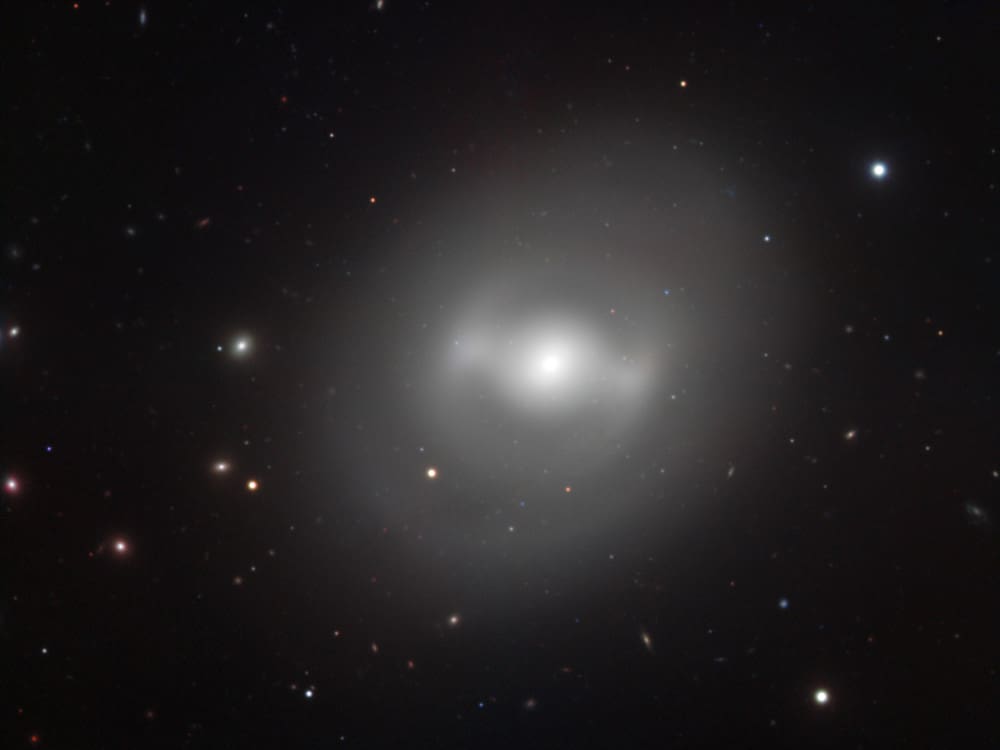Blog
https://www.youtube.com/watch?v=GhgHFp6w1bM
more...The Seagull Nebula (IC 2177) is an emission nebula in the constellation Monoceros the Unicorn. It lies some 3,600 light-years away. This image, taken through filters similar to those used by the Hubble Space Telescope, shows the object’s birdlike shape.

Steve Khan (born April 28, 1947) is an American jazz guitarist.
According to Steve Khan, his father, lyricist Sammy Cahn, “loved to hear of any and all versions of his songs”. Thus Khan grew up in a house with music. He took piano lessons as a child and played drums for the surf rock band the Chantays. The band’s guitarist exposed him to the albums Tough Talk by The Crusaders and Movin’ Wes by Wes Montgomery. In his late teens he quit the drums and started playing guitar. He was a member of the R&B band Friends of Distinction, recorded with keyboardist Phil Moore, then played on the album Bullitt by Wilton Felder (“one of my heroes”). Despite his father’s advice to avoid a career in the music business, he graduated from UCLA with a degree in music composition and theory.
In the early 1970s, he performed in an acoustic guitar duo with Larry Coryell and was a member of the Brecker Brothers band. As a session musician, he appeared on albums by Ashford & Simpson, Rupert Holmes, Billy Joel, and Steely Dan. He was signed to Columbia Records through the efforts of Bobby Colomby and Bob James. On his first three albums Tightrope (1977), The Blue Man (1978), and Arrows (1979), he was trying “to single-handledly keep alive the sound of the original Brecker Brothers band.” His next album was Evidence (1980), which contained an eighteen-minute medley of songs by Thelonious Monk. In 1977, he toured with the CBS Jazz All-Stars which included Billy Cobham, Tom Scott, and Alphonso Johnson, and then led the ground-breaking band called Eyewitness that featured musicians: Steve Jordan, Anthony Jackson and Manolo Badrena. In 1986, he toured as part of Joe Zawinul’s Weather Update. From 1999 through 2002, he co-led the Caribbean Jazz Project alongside Dave Samuels and Dave Valentín. From the 1980s through to the present, he has become the foremost proponent of the guitar in Latin Jazz. With the releases of Parting Shot (2011), Subtext (2014), and Backlog (2016), he has created what the role of the guitar could be in Latin jazz.
more...Mickey Tucker (born April 28, 1941, in Durham, North Carolina) is an American jazz pianist and organist.
When he was six, he started on piano, eventually playing in church. He performed in the 1960s with Little Anthony and the Imperials and Damita Jo, and also accompanied comedian Timmy Rogers. He entered the jazz world in 1969, working for the next several years with Eric Kloss, Rahsaan Roland Kirk, James Moody, the Thad Jones/Mel Lewis Orchestra, Eddie Jefferson, and George Benson. He was music director for Art Blakey and the Jazz Messengers. During the 1980s, he appeared on albums by Phil Woods, Art Farmer, Richie Cole, and Benny Golson.
more...John Martin Tchicai (April 28, 1936 – October 8, 2012) was a Danish free jazz saxophonist and composer.
After moving to New York City in 1963, Tchicai joined Archie Shepp‘s New York Contemporary Five and the New York Art Quartet. He played on John Coltrane‘s Ascension, and Albert Ayler’s New York Eye and Ear Control, both influential free jazz recordings.
Tchicai was born in Copenhagen, Denmark, to a Danish mother and a Congolese father. The family moved to Aarhus, where he studied violin in his youth, and in his mid-teens began playing clarinet and alto saxophone, focusing on the latter. By the late 1950s he was travelling around northern Europe, playing with many musicians.
Following his work in New York, Tchicai returned to Denmark in 1966, and shortly thereafter focused most of his time on music education. He formed the small orchestra Cadentia Nova Danica with Danish and other European musicians; this group collaborated with Musica Elettronica Viva and performed in multi-media events. Tchicai was a founding member of Amsterdam‘s Instant Composers Pool in 1968, and in 1969 took part in the recording of John Lennon and Yoko Ono‘s Unfinished Music No.2: Life with the Lions.
https://www.youtube.com/watch?v=kwqCyMsLV1Y
more...Mario Bauzá (April 28, 1911 – July 11, 1993) was a jazz, Latin, and Afro-Cuban jazz musician. He was one of the first to introduce Cuban music to the United States by bringing Cuban musical styles to the New York City jazz scene. While Cuban bands had had popular jazz tunes in their repertoire for years, Bauzá’s composition “Tangá” was the first piece to blend jazz harmony and arranging technique, with jazz soloists and Afro-Cuban rhythms. It is considered the first true Afro-Cuban jazz or Latin jazz tune.
As a child he studied clarinet becoming recognized as a child prodigy on the instrument leading to being featured with the budding Havana Symphony at the age of 11. Bauzá then performed on clarinet and bass clarinet with pianist Antonio Maria Romeu’s charanga (flute and violins) orchestra. This proved a fateful event as the orchestra came to New York City to record in 1926. Bauzá’s stayed with his cousin, trumpeter René Endreira, who was a Harlem resident and played with The Santo Domingo Serenaders, a band was made up of Panamanians, Cubans, and Puerto Ricans of color playing jazz. The teenage Bauzá was impressed with Harlem’s African American community and the freedom they had. He also witnessed a performance of George Gershwin’s “Rhapsody In Blue” and was inspired with saxophonist Frankie Trumbauer’s feature in the piece. Upon his return to Cuba he vowed he would return to New York City to become a jazz musician doing so in 1930 learning to play the alto saxophone while maintaining his clarinet technique. A chance encounter with vocalist Cuban vocalist Antonio Machin, who needed a trumpet player for an upcoming record date he was leading gave Bauzá an unusual opportunity. Machin was the vocalist for the Don Azpiazú Havana Casino Orchestra who had taken New York City by storm with their public performances and recent hit recording of “El Manisero,” The Peanut Vendor. Machin was offered a record date to record four tunes. Machin when he would perform solo would do so with two guitars, a trumpet, and himself on maracas. All the trumpet players that knew how to play in the Cuban style who were part of Azpiazú’s orchestra had left to back to Cuba. Faced with a dilemma Bauzá offered his services to Machin because he knew the finger positions on the horn buying a trumpet and in two weeks developed enough technique to play on the recordings. He would now devote his time to playing the instrument being inspired by Louis Armstrong. By 1933 Bauzá had been hired as lead trumpeter and musical director for drummer Chick Webb‘s Orchestra, and it was during this time with Webb that Bauzá both met fellow trumpeter Dizzy Gillespie and allegedly discovered and brought into the band singer Ella Fitzgerald.
In 1938 Bauzá joined Cab Calloway‘s band, later convincing Calloway to hire trumpeter Dizzy Gillespie. He would leave Calloway’s band in 1940. Bauzá’s musical relationship and friendship with Gillespie would continue yielding game changing results. The fusion of Bauzá’s Cuban musical heritage and Gillespie’s bebop culminated in the development of cubop, one of the first forms of Latin jazz.
In 1939, Bauzá became co-founder and musical director of Machito and his Afro-Cubans with his vocalist brother-in-law, Francisco Raúl Guittierez Grillo (Machito). The band produced its first recordings for Decca in 1941, and in 1942 Bauzá brought in a young timbalero named Tito Puente.
more...Glowing in the cosmos at a distance of about 50 million light-years away, the galaxy NGC 936 bears a striking resemblance to the Twin Ion Engine (TIE) starfighters used by the evil Dark Lord Darth Vader and his crew in the epic motion picture Star Wars. The galaxy’s shiny bulge and a bar-like structure crossing it bring to mind the central engine and cockpit of the spacecraft; while a ring of stars surrounding the galactic core completes the parallel, corresponding to the wings of the TIE fighters that are equipped with solar panels.
This galaxy harbours exclusively old stars and shows no sign of any recent star formation. Bars such as that observed in NGC 936 are common features of galaxies; however, this one is significantly more marked than average. Although a perfect symbol for the dark side of the “Force”, it is still debatable whether this galaxy is dominated, like most others, by a large amount of dark matter.
This image has been obtained using the FORS instrument mounted on one of the 8.2-metre telescopes of ESO’s Very Large Telescope on top of Cerro Paranal, Chile. It combines data acquired through four wide-band filters (B, V, R, I). The field of view is about 7 arcminutes.

James Lee Keltner (born April 27, 1942) is an American drummer known primarily for his session work. He was characterized by Bob Dylanbiographer Howard Sounes as “the leading session drummer in America”.
Keltner was initially inspired to start playing because of an interest in jazz, but the popularity of jazz was declining during the late 1950s and early 1960s, and it was the explosion of pop/rock in the mid-1960s that enabled him to break into recording work in Los Angeles. His first gig as a session musician was recording “She’s Just My Style” for the pop group Gary Lewis and the Playboys.
Keltner’s music career was hardly paying a living, and for several years at the outset he was supported by his wife. Toward the end of the 1960s, he finally began getting regular session work and eventually became one of the busiest drummers in Los Angeles. His earliest credited performances on record were with Gabor Szabo on the 1968 album Bacchanal.
In 1968, Keltner was also working in a music shop in Pasadena just down the street from the old “Ice House” coffeehouse when he was recruited to play drums in a “psychedelic” vocal group named “MC Squared” along with Michael Crowley, Michael Clough, Linda Carey, (all from the folk group The Back Porch Majority) and session guitarist/bassist Randy Cierley Sterling. They were signed by Mo Ostin and recorded an album for Warner/Reprise originally titled “MC Squared” which has later been re-mastered and re-released in 2012 with the album title “Tantalizing Colors.”They appeared live that same year on the Hugh Hefner / Playboy Magazine television show Playboy After Dark playing two songs: an original by MC Squared members Michael Clough and Michael Crowley titled “I Know You” and a cover version of the Fred Neil song Everybody’s Talkin’. Both Playboy After Dark performances with Keltner playing drums can currently be viewed on YouTube.
It was his work with Leon Russell playing on Delaney & Bonnie’s Accept No Substitute that attracted the attention of Joe Cocker, who recruited Russell and everyone else he could out of the Delaney & Bonnie band for his Mad Dogs & Englishmen tour. Playing with Joe Cocker led to work in 1970 and 1971, on records by Carly Simon (No Secrets), Barbra Streisand (Barbra Joan Streisand), Booker T. Jones (Booker T. & Priscilla), George Harrison (The Concert for Bangladesh), and John Lennon (Imagine).
more...Frederick “Freddie” Douglas Waits (April 27, 1943 – November 18, 1989) was a hard bop and post-bop drummer.
He never officially recorded as leader, but was a prominent member and composer in Max Roach‘s M’Boom percussion ensemble.
He worked as sideman with a number of influential pianists, including McCoy Tyner, Kenny Barron, Andrew Hill, Gene Harris, Billy Taylor and Joe Zawinul.
In 1967, Waits recorded with Freddie Hubbard.
He was a member of the last Lee Morgan Quintet, a journey cut short by Morgan’s murder in 1972.
In the late 1970s, Waits formed Colloquium III with fellow drummers Horace Arnold and Billy Hart. In the 1980s he became a music faculty member of Rutgers University. He died of pneumonia and kidney failure in New York in 1989.
His son is the drummer Nasheet Waits.
more...Conrad Henry Kirnon (April 27, 1927 – November 30, 1994) known professionally as Connie Kay, was an American jazz and R&B drummer, who was a member of the Modern Jazz Quartet.
Self-taught on drums, he began performing in Los Angeles in the mid-1940s. His drumming is recorded in The Hunt, the recording of a famous Los Angeles jam session featuring the dueling tenors of Dexter Gordon and Wardell Gray on July 6, 1947. He recorded with Lester Young‘s quintet from 1949 to 1955 and with Stan Getz, Coleman Hawkins, Charlie Parker, and Miles Davis.
Kay did R&B sessions for Atlantic Records in the early to mid-1950s, and he was featured on hit records such as Shake, Rattle and Roll by Big Joe Turner and Ruth Brown‘s (Mama) He Treats Your Daughter Mean.
Kay joined the Modern Jazz Quartet in 1955, replacing original drummer Kenny Clarke. He remained through the group’s dissolution in 1974 and occasional reunions into the 1990s. In addition to his MJQ compatriots, he had an enduring partnership with cool jazz altoist Paul Desmond through the first half of the 1960s. He played drums on several of Irish singer-songwriter Van Morrison‘s albums: Astral Weeks, one song on Saint Dominic’s Preview, and four songs on Tupelo Honey.
Kay was known for incorporating percussion instruments alongside his drum kit, such as timpani, small cymbals, triangle, bell tree, and darbukas, the latter referred to as “exotic-looking” drums in a 2006 article.
In 1989, Kay received an honorary doctorate of music from Berklee College of Music.
Kay had a stroke in 1992, but recovered enough to resume performing. He died of cardiac arrest in Manhattan in 1994 at the age of 67. He was survived by his wife, Addie, and two sons.
more...Herbig Haro 901 is an immense pillar of gas and dust inside the Carina Nebula, a huge star-forming region in our galaxy. The pillar is several light-years tall and contains a few massive young stars. They shoot out powerful jets that emerge from the cloud. In some cases, the jets create bow-shock patterns similar to the effects of a ship plowing through the ocean. In the visible-light (Hubble) view, very few stars can be seen because the gas and dust block starlight. But in the infrared (Hubble) view, stars become visible and numerous. The visible-light colors emerge from the glow of different gases: oxygen (blue), hydrogen/nitrogen (green), and sulfur (red). The Carina Nebula is approximately 7,500 light years from Earth. C

Lakshminarayana Shankar (born 26 April 1950), also known as L. Shankar and Shenkar, (aka L.Shankar, Shankar) is an Indian violinist, vocalist, composer and record producer.
Shenkar created and designed his own invention, the first of its kind 10 string stereophonic Double Violin, built by Ken Parker. The Double Violin covers the entire range of the orchestra. He formed the groundbreaking band Shakti with the British guitarist John Mclaughlin, Zakir Hussain and Vikku Vinayakram and toured the world. He also performed extensively his Indian classical tours with Zakir Hussain and Vinayakram. He recorded 8 world music albums for the reputed German label ECM and toured extensively featuring the renowned Sax Player Jan Garbarek, Kenny Wheeler, Don Cherry, Ed Blackwell, Trilok Gurtu in many Jazz and world music festivals organized by his label ECM featuring other ECM artists such as Keith Jarrett, Jack DeJohnette etc.
Shenkar’s pop DVD, “One in a Million”, became the number 1 DVD in the US spending 4 weeks on top of the U.S. Soundscan/Billboard charts. Shenkar has also collaborated with Frank Zappa (who produced Shenkar’s solo record for Zappa Records), Talking Heads, Pete Townsend, Lou Reed, Marianne Faithful, Sting, Jeff Beck, U2, The Pretenders, Echo & The Bunnymen, John Lydon (Public Image Ltd.), George Harrison, Michael Jackson, Madonna, Dave Stewart, Pete Townsend (The Who), Peter Gabriel, Jonathan Davis (Korn), Robert Trujillo (Metallica), Stephen Perkins (Jane’s Addiction) and many more.
more...More Posts
- World Music with Odpoczno
- Daily Roots with Ras Tweed
- The Cosmos with M8
- Johnny “Big Moose” Walker Day
- Elmo Hope Day
- Shad Collins Day
- World Music with Eleftheria Arvanitaki
- Daily Roots with Israel Vibration
- The Cosmos with NGC 1187
- Reggie Workman Day
- Big Bill Broonzy Day
- World Music with Very Be Careful
- Daily Roots with Uwe Banton
- The Cosmos with M20
- Joe Chambers Day
- Clifton Chenier Day
- Johnny Smith Day
- World Music with Haig Yazdjian
- Daily Roots with Peter Tosh
- Your Community Band 6-24-18 2pm